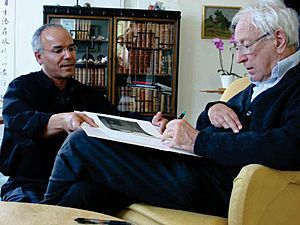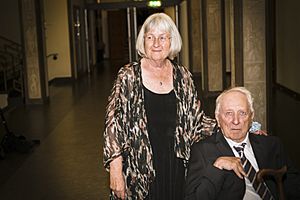Tomas Tranströmer facts for kids
Quick facts for kids
Tomas Tranströmer
|
|
|---|---|

Tranströmer during the Writers' and Literary Translators' International Conference in June 2008
|
|
| Born | Tomas Gösta Tranströmer 15 April 1931 Stockholm, Sweden |
| Died | 26 March 2015 (aged 83) Stockholm, Sweden |
| Occupation |
|
| Alma mater | Stockholm University |
| Period | 1954–2015 |
| Notable works |
|
| Notable awards | Nobel Prize in Literature 2011 |
| Spouse | Monika Bladh |
Tomas Gösta Tranströmer (born April 15, 1931 – died March 26, 2015) was a famous Swedish poet, psychologist, and translator. His poems often described the long Swedish winters and the beautiful changes of nature through the seasons.
Tranströmer's writing also explored a sense of wonder and mystery hidden in everyday life. This often gave his poems a spiritual feeling. He is known as one of the most important writers in Scandinavia since World War II. Many people praised his poetry because it was easy to understand, even when translated into other languages. His poems have been translated into more than 60 languages around the world. He won several major awards, including the 2011 Nobel Prize in Literature.
Contents
About Tomas Tranströmer
His Early Life and Education
Tomas Tranströmer was born in Stockholm, Sweden, in 1931. His mother, Helmy, raised him after she and his father divorced. He went to high school in Stockholm, where he started writing poetry.
His first collection of poems, 17 Poems, was published in 1954. He continued his studies at Stockholm University. In 1956, he graduated as a psychologist. He also studied history, religion, and literature.
Between 1960 and 1966, Tranströmer worked as a psychologist. He helped young people at a center for juvenile delinquents. He also worked as a psychologist at the Labor Market Institute in Västerås until 1990.
His Poetry and Writing Style
Tomas Tranströmer is considered one of the most important Scandinavian poets of recent times. He published 15 collections of poems during his long career. These works have been translated into over 60 languages.
In the mid-1960s, Tranströmer became good friends with the American poet Robert Bly. They wrote to each other often, and Bly translated many of Tranströmer's poems into English. Their letters, which talked about personal and literary topics, were later published in a book called Air Mail. Bly also helped arrange poetry readings for Tranströmer in America. The Syrian poet Adunis also helped share Tranströmer's poems in the Arab world.
Some poets in the 1970s thought Tranströmer's poems were not connected enough to current events. This was because he didn't directly write about social or political issues. However, his work used clear, simple images from everyday life and nature. These images often showed a deeper, mysterious understanding of human thoughts and feelings. A poem by him was read at the memorial service for Swedish politician Anna Lindh in 2003.
In 1984, Tranströmer visited Bhopal, India, right after a terrible gas tragedy. He took part in a poetry reading there with Indian poets.
In 1990, Tranströmer had a stroke. This left him partly paralyzed and unable to speak. Even so, he continued to write and publish poetry. One of his last books of poems, Den stora gåtan (The Great Enigma), came out in 2004.
His Love for Music
Tranströmer loved playing the piano throughout his life. After his stroke, he could only use his left hand. He taught himself to play the piano using just one hand. He often said that playing music helped him keep living after his stroke.
His daughter, Emma, is a concert singer. In 2011, she released an album called Dagsmeja. The songs on this album were based on Tranströmer's poems. Many other composers and musicians have also used his poems in their music.
His Passing
Tomas Tranströmer passed away in Stockholm on March 26, 2015. He was 83 years old.
List of His Works
Books of Poetry
- 17 Poems (17 dikter), 1954
- Secrets on the Way (Hemligheter på vägen), 1958
- The Half-Finished Heaven (Den halvfärdiga himlen), 1962
- Bells and Tracks (Klanger och spår), 1966
- Seeing in the Dark (Mörkerseende), 1970
- Paths (Stigar), 1973
- Baltics (Östersjöar), 1974
- The Truthbarrier (Sanningsbarriären), 1978
- The Wild Market Square (Det vilda torget), 1983
- For the Living and the Dead (För levande och döda), 1989
- The Sorrow Gondola (Sorgegondolen), 1996
- Prison (Fängelse), 2001 (written in 1959)
- The Great Enigma (Den stora gåtan), 2004
Other Writings
- Memories Look at Me (Minnena ser mig), 1993, a prose memoir
- Air Mail: Brev 1964-1990, 2001, his letters with Robert Bly
- Galleriet: Reflected in Vecka nr. II, 2007, an artist book by Modhir Ahmed
Translations of His Work
In English
- Twenty Poems translated by Robert Bly, 1970
- Night Vision: Mörkerseende translated by Robert Bly, 1972
- Windows and Stones translated by May Swenson & Leif Sjoberg, 1972
- Selected Poems, translated by Robin Fulton, 1974
- Baltics: Östersjöar, translated by Samuel Charters, 1975
- Baltics: Östersjöar, translated by Robin Fulton, 1980
- Selected Poems, translated by Robin Fulton, 1981
- The Blue House: Prose Poems, 1983
- The Wild Market Square: Det vilda torget translated by John F. Deane, 1985
- Collected Poems, translated by Robin Fulton, 1987
- Tomas Tranströmer: Selected Poems, 1954–1986, edited by Robert Hass, 1987
- Sorrow Gondola: Sorgegondolen, translated by Robin Fulton, 1994
- For the Living and the Dead: För levande och döda, translated by John F. Deane, 1994
- New Collected Poems translated by Robin Fulton, 1997
- Selected Poems Transtromer, translated by May Swenson, Eric Sellin, 1999
- The Half-Finished Heaven translated by Robert Bly, 2001
- The Deleted World translated by Robin Robertson, 2006
- The Great Enigma: New Collected Poems, translated by Robin Fulton, 2006; republished 2011
- The Sorrow Gondola translated by Michael McGriff and Mikaela Grassl, 2010
- The Deleted World translated by Robin Robertson, 2011
- New Collected Poems translated by Robin Fulton, expanded edition, 2011
- Inspired Notes, translated by John F. Deane, 2011
- Bright Scythe: Selected Poems by Tomas Tranströmer, translated by Patty Crane, Bilingual edition, 2015
In Other Languages
- Hanns Grössel translated some of Tranströmer's works into German.
- Roberto Mascaró translated his work into Spanish.
- Morteza Saghafian translated his work into Persian.
- Maria Cristina Lombardi translated some works into Italian.
- Jacques Outin translated them into French.
- Milan Richter translated his collected poems into Slovak (Medzi allegrom a lamentom, 2001).
Awards and Honours
- 1966: Bellman Prize (Sweden)
- 1981: Petrarca-Preis (Germany)
- 1990: Neustadt International Prize for Literature (US)
- 1990: Nordic Council Literature Prize, for For the Living and the Dead (Nordic countries)
- 1991: Swedish Academy Nordic Prize (Sweden)
- 1992: Horst Bienek Prize for Poetry (Germany)
- 1996: Augustpriset, for Sorgegondolen (Sweden)
- 1998: Jan Smrek Prize (Slovakia)
- 2003: Struga Poetry Evenings Golden Wreath (Macedonia)
- 2004: International Nonino Prize (Italy)
- 2007: The Griffin Trust, Lifetime Recognition Award (Griffin Poetry Prize) (Canada)
- 2011: Title of Professor, granted by the Cabinet of Sweden (Sweden)
- 2011: Nobel Prize in Literature (Sweden)
He also received other awards, including the Övralid Prize and the Swedish Award from the International Poetry Forum.
See also
 In Spanish: Tomas Tranströmer para niños
In Spanish: Tomas Tranströmer para niños



